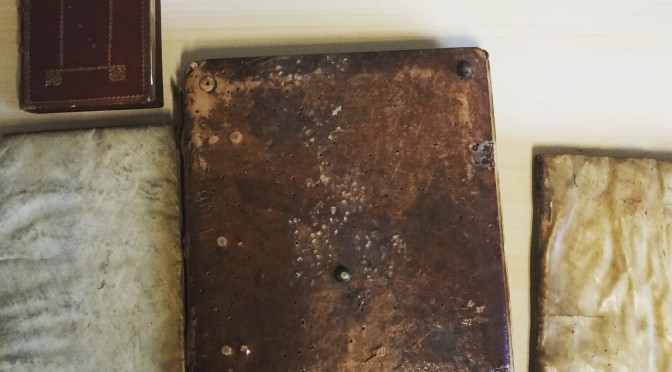When is a book not a book? The destruction of a book – through burning, through recycling, through iconoclasm, for instance – places great emphasis on its materiality, its power as a physical object that must be destroyed. Conversely, when nobody knows about a book’s existence, it simply disappears – both the physical book and the textual lives inside it. When a book is unknown and hidden away it is perhaps reduced to the bare facts of its existence: a piece of matter unread, unloved, unvalued, uncatalogued.
Books disappear easily when they are not catalogued; it is through catalogues and finding aids that medievalists find their sources. When I joined Birkbeck College as a lecturer in 2002, I was excited to find that the College owned one manuscript, which I knew about from Neil R. Ker’s magisterial four-volume catalogue, Medieval Manuscripts in British Libraries. But time passed, I became diverted by other projects, and I never got round to looking at the manuscript. And then I more or less forgot about it.
This year I have been teaching a class on ‘Medieval Material Texts’ for students on Birkbeck’s MA in Medieval Literature & Culture. It struck me that it would be so much easier to talk about medieval books if one had one to show to the students – to talk about the binding, the physical construction of a book, the stains and the damage, the signs of a book’s lived life, as well as the text, the decoration, the illustration. So, somewhere in the back of my mind, I remembered Ker’s description of one manuscript, and looked it up, and sent an email off to my subject-librarian at Birkbeck’s library.
It was as much as a surprise to the College as it was to me to  discover that Birkbeck houses a small collection of not one but four medieval books (three manuscripts and one incunabulum). I quickly arranged to view the books, three of which have not been catalogued and do not seem to have been viewed since around 1991. The books comprise a sort of ‘capsule collection’: they represent several important developments in European religious culture, in book history, and in literary tastes.
discover that Birkbeck houses a small collection of not one but four medieval books (three manuscripts and one incunabulum). I quickly arranged to view the books, three of which have not been catalogued and do not seem to have been viewed since around 1991. The books comprise a sort of ‘capsule collection’: they represent several important developments in European religious culture, in book history, and in literary tastes.
The books are:

The Birkbeck Hours (sine numero): a beautiful small book of hours, from northern France, dated to c. 1400.
MS L.I: the rules and customs of the Capitoli della Compagnia di S. Girolamo of Siena, dated to the early fifteenth century.
MS 108.C: a manuscript of the Sententiae Sapientiae, attributed to Aristotle, Plato, Socrates, and Seneca, and which once belonged to the Monastery of St Zeno, Verona; dated to c. 1450.
Dictys Cretensis & Dares Phrygius (sine numero): a skin-bound volume, a much-read history of the Trojan War, printed at Venice, 1499.

One of the manuscripts, the Birkbeck Hours, was given to the College in 1977 by the widow of Dr Charles Fox (1897-1977), a lecturer at Birkbeck who later became a distinguished mathematician at Concordia University in Montreal. How the other three manuscripts reached Birkbeck is not known at present, although we do know that MS L.I was purchased by the College in the 1950s, probably to be used as a teaching aid. Ownership inscriptions in MS 108.C show that, in the nineteenth century, it belonged to a Peter John Bruff and, later, the Victorian scholar and antiquarian R. A. H. Bickford-Smith (1859-1916).
The books open a window onto readers and writers from hundreds of years ago; by coming back into public view, they can delight and instruct again. A more detailed examination of the books will, in time, yield much more about the lives these fascinating books have lived, and continue to live.
NB: The books are not currently available for public view, but it is hoped that a digitisation project will make them available online in due course.
